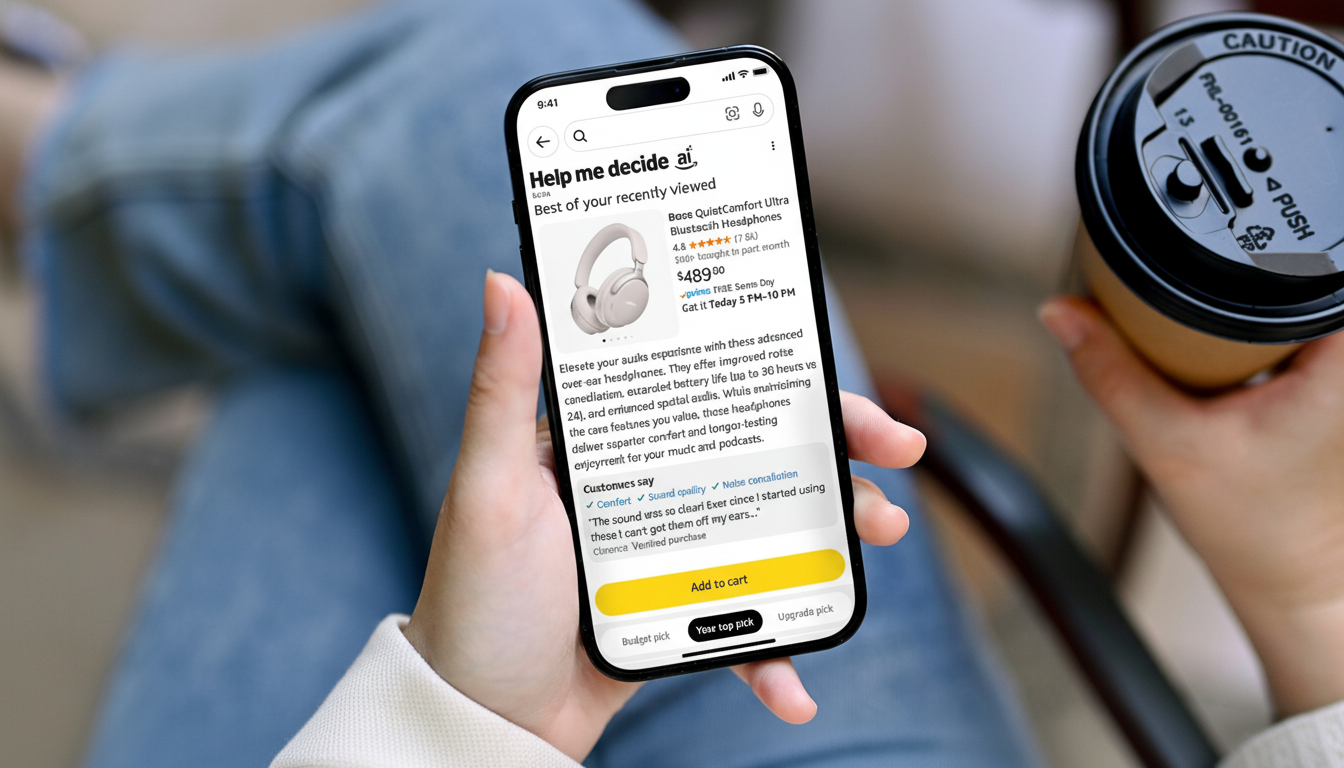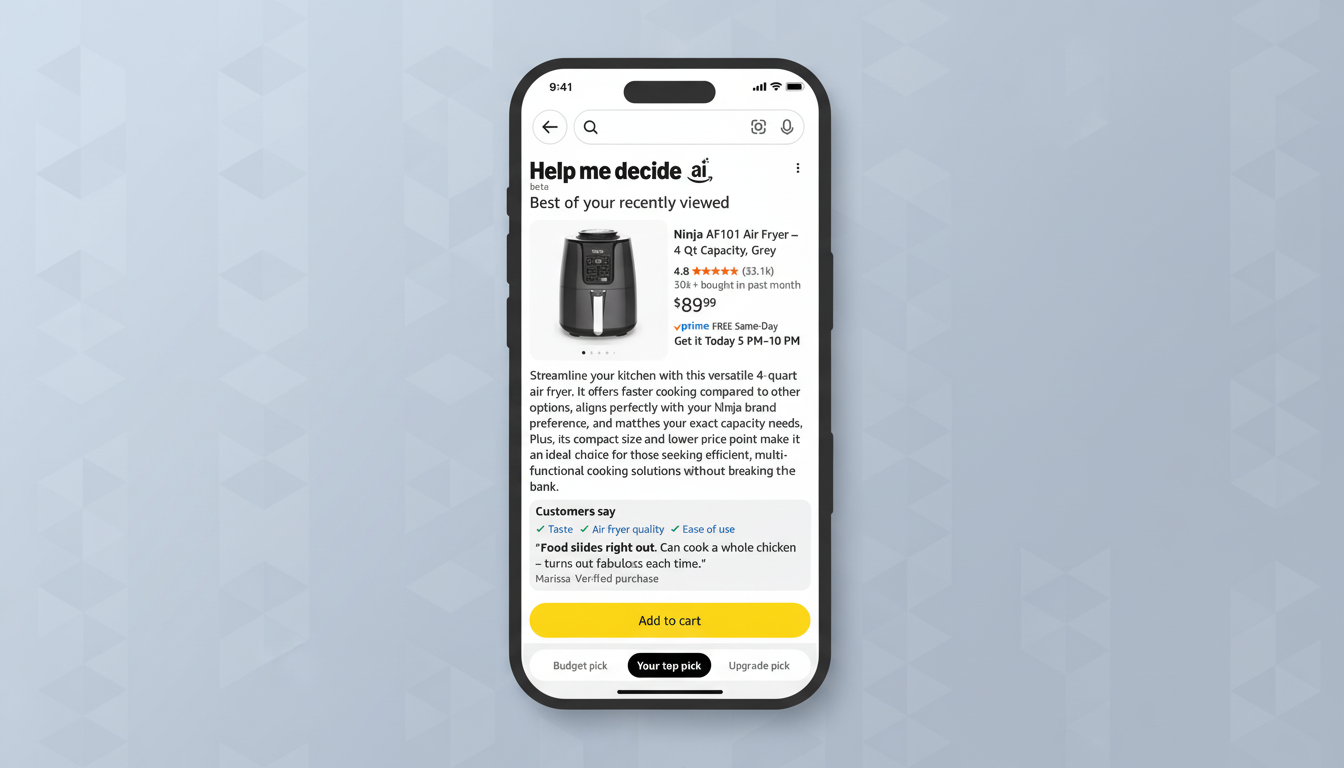Amazon is rolling out a new AI feature called Help Me Decide that not only recommends products, but also explains why a specific item fits what you’ve been looking for. It’s the latest move in the retail giant’s push to turn browsing behavior into tailored advice that feels more like a seasoned store associate than a search bar.
How the Help Me Decide tool works for smarter shopping
Help Me Decide analyzes your on-Amazon activity—recent searches, product views, and purchases—to surface a single, contextual pick and a short rationale. If you’ve been comparing four-person tents, reading about weather ratings, and recently bought hiking boots, it might recommend an all-season, four-person model and spell out why it matches your needs.
- How the Help Me Decide tool works for smarter shopping
- The technology behind Amazon’s explainable recommendations
- Availability and rollout across app and web in the U.S.
- Privacy, data use, and shopper trust in AI guidance
- Where it fits in the fast-evolving AI shopping race
- What sellers should do now to optimize for AI picks
- The bottom line on Amazon’s Help Me Decide feature

The feature starts within the price range you’re currently browsing, but you can ask for cheaper or pricier alternatives. You’ll see a Help Me Decide button after you’ve looked through multiple similar listings, and it also appears under the Keep shopping for section on the homepage.
Early examples show short, plain-language “why this” summaries that weigh attributes like size, compatibility, durability, and customer sentiment—an attempt to cut the cognitive load of comparing near-identical listings.
The technology behind Amazon’s explainable recommendations
Under the hood, Amazon is combining large language models with in-house infrastructure, including AWS Bedrock for generative AI, OpenSearch for retrieval, and SageMaker for recommendations. That stack lets the system pull in product details and reviews, add your context, and generate an explanation in real time.
The big bet is that explainability moves the needle. E-commerce research from the Baymard Institute has long highlighted decision fatigue as a conversion killer, with cart abandonment hovering around 70%. Short, relevant justifications could reduce the back-and-forth of tab-hopping and nudge shoppers to commit with less second-guessing.
Availability and rollout across app and web in the U.S.
Help Me Decide is launching to U.S. customers across the Amazon Shopping app on iOS and Android, as well as the web. Amazon says it will appear when the system detects high-intent comparison behavior—think repeated views within the same category—rather than on every product page.
The release builds on a string of AI additions: the Rufus shopping assistant that answers product questions, AI-generated buying guides spanning 100+ categories, audio summaries of product reviews, and Lens Live, which turns your phone camera into a visual search tool for lookalike products.

Privacy, data use, and shopper trust in AI guidance
Help Me Decide relies on first-party signals—your on-site browsing and purchase history—to personalize recommendations. Amazon already provides controls to edit or clear browsing history and adjust ad preferences, and those settings will matter even more as AI-driven features become more context-aware.
As with any generative system, accuracy and transparency are key. Amazon says the goal is to save shoppers time and boost confidence by aligning suggestions with stated intent. That promise will be tested in edge cases where product data is thin, attributes are mislabeled, or reviews are inconsistent—scenarios where models can overgeneralize.
Where it fits in the fast-evolving AI shopping race
Tech heavyweights are converging on AI-assisted commerce. Google is weaving generative answers into shopping queries and tapping its Shopping Graph, while OpenAI and Perplexity are experimenting with conversational product suggestions. Retailers from Walmart to Shopify are embedding AI agents that translate needs into product shortlists.
Amazon still holds a commanding share of U.S. e-commerce, and analysts at eMarketer estimate it accounts for roughly 40% of online retail. An explainer-based recommender lets Amazon play to its strengths—massive catalog depth, dense review data, and rich first-party signals—while differentiating with reasons, not just rankings.
What sellers should do now to optimize for AI picks
If AI is synthesizing the “why,” product data quality becomes make-or-break. Brands should tighten structured attributes (dimensions, compatibility, materials), use precise titles and bullet points, and keep pricing and variants cleanly mapped. High-quality images, clear size charts, and review response strategies can also feed better model outputs.
The upside is straightforward: when the model can quickly match a shopper’s intent to verifiable attributes and credible reviews, your product is more likely to be the one it can justify—instantly and persuasively.
The bottom line on Amazon’s Help Me Decide feature
Help Me Decide shifts Amazon from recommendation to rationale, meeting shoppers at the moment of uncertainty with a tailored explanation. If it works as advertised—accurate, transparent, and privacy-aware—it could convert indecision into action and set a new baseline for AI in retail discovery.

